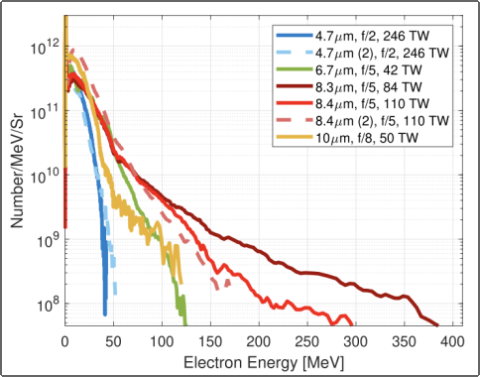H. Tang, K. Tangtartharakul, R. Babjak, I-L Yeh, F. Albert, H. Chen, P. T. Campbell, Y. Ma, P. M. Nilson, B. K. Russell, J. L. Shaw, A. G. R. Thomas, M. Vranic, A. Arefiev, and L. Willingale, "The influence of laser focusing conditions on the direct laser acceleration of electrons", New J. Phys. 26, 053010 (2024).
Direct laser acceleration of electrons during a high-energy, picosecond laser interaction with an underdense plasma has been demonstrated to be substantially enhanced by controlling the laser focusing geometry. Experiments using the OMEGA EP facility measured electrons accelerated to maximum energies exceeding 120 times the ponderomotive energy under certain laser focusing, pulse energy, and plasma density conditions. Two-dimensional particle-in-cell simulations show that the laser focusing conditions alter the laser field evolution, channel fields generation, and electron oscillation, all of which contribute to the final electron energies. The optimal laser focusing condition occurs when the transverse oscillation amplitude of the accelerated electron in the channel fields matches the laser beam width, resulting in efficient energy gain. Through this observation, a simple model was developed to calculate the optimal laser focal spot size in more general conditions and is validated by experimental data.
